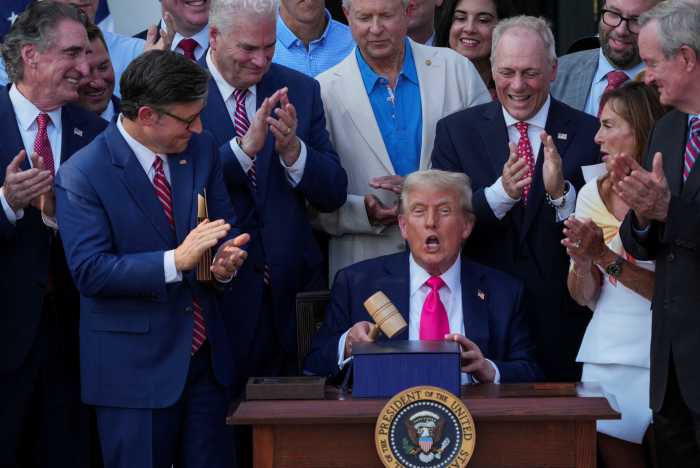By Bill Parry
Children are bearing the brunt of South Corona’s exploding population, according to several elected officials. Standing in front of classroom trailers at PS 16 on 114th Street, they demanded an immediate response to the district’s overcrowded schools, urging the city to downgrade South Corona’s existing zoning code to lower the neighborhood’s density.
“What was a one- or two-family home now becomes a six- or seven-story building,” state Assemblyman Francisco Moya (D-East Elmhurst) said. “In South Corona, we see the consequences of letting too much happen too soon. The neighborhood can’t absorb the burgeoning population and students end up suffering for it. Our schools are well over-capacity, forcing students to cram into unsafe trailers that are frigid in the winter and microwaves in the summer. Downzoning South Corona would alleviate some of the pressure these schools face and buy time for Corona’s infrastructure to begin catching up where it needs to be.”
According to the U.S. Census in 2010 , after the Rockaways, Corona had the steepest climb in population within Queens with a 3.3 percent increase between 2000 and 2010. PS 16 is currently at 144 percent capacity, while PS 28 operates at 178 percent capacity.
“There is a clear need to look at all possible ways to alleviate the chronic school overcrowding that has been affecting our district for years and decades,” state Sen. Jose Peralta (D-East Elmhurst) said. “Not far from here, for example, PS 143, built for 900 students, had en enrollment of 1,284 schoolchildren for the year 2008-09, jumping to 1,782 for the academic year 2012-13. Construction of new schools has not kept up with the growing population, and this is why it is important the city considers downgrading the current zoning codes in the effort to keep one- and two-family homes, which have been replaced with multi-family, multi-dwelling residences, thus creating the number of students.”
Downzoning would alleviate the pressure on the schools and buy time for the infrastructure to catch up, according to Moya, who said the No. 7 subway line operates at 97 percent capacity at rush hour.
“It is irresponsible, and unfair to the families that live in our communities, to allow the overdevelopment of our neighborhoods without first investing in our infrastructure and ensuring we’re able to provide the services they need and deserve,” U.S. Rep. Joseph Crowley (D-Jackson Heights) said. “That lack of fairness is all the more evident by the conditions under which many of the children in South Corona are forced to learn in.”
Downzoning South Corona to a lower designation would limit density and the trend of replacing homes with high-rise buildings.
“We’re seeing overdevelopment at an alarming rate,” Community Board 4 District Manager Christian Cassagnol said. “The fact is that large sections of Corona were designed as a tightly woven network of one to two-family houses whose streets are far too narrowand simply not prepared to handle such an influx of population in such a short amount of time.”
City officials said in the last two years, more than 3,000 new school seats have been provided; and the City has another 1,800 seats in the pipeline for the Corona community.
“We are working closely with elected officials and other community leaders to alleviate the pressures on our City infrastructure without hurting what is an increasingly thriving New York neighborhood,” City Hall Spokeswoman Melissa Grace said.
Reach reporter Bill Parry by e-mail at bparr




































